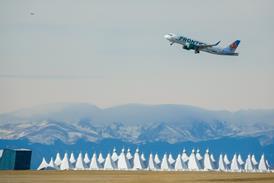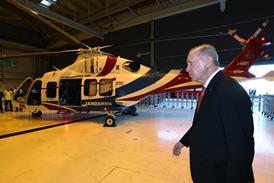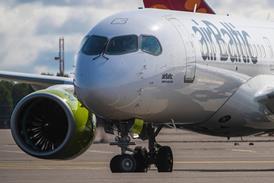Julian Moxon/PARIS

It used to be said that a helicopter, with its complex mechanics and whirling, vibration-producing, aerodynamic surfaces, was best described as "a million individual components flying in close formation". While it may be amusing, the image is becoming less credible as new technology is applied to resolving the problems that initially gave rise to the joke.
Research under way at Eurocopter is aiming at a new breed of machine that will offer passengers regional airliner levels of comfort, and pilots a higher degree of all-weather safety.
Many advances in helicopter technology have been pioneered by the European industry, including the introduction of turbine power (the Alouette II in 1955), the rigid rotor (the BO105 in 1967), the all-composite rotor (the Ecureuil in 1974) and bearingless main rotor (the BO108 in 1988). More recently, NH Industries has claimed a breakthrough with the first use on a transport helicopter, its NH90, of a fly-by-wire flight control system.

Eurocopter research director Philippe Galland says new technology should be used only when there is a strong enough argument for its introduction. For example, Eurocopter concluded that the McDonnell Douglas no-tail rotor (Notar) system, despite its safety advantages, was unsuitable for producing the anti-torque reaction to the main rotor because it was difficult to maintain and had poor cross-wind performance. Instead, Eurocopter stuck with its own fenestron shrouded tail rotor, now applied to all of its civil helicopters, arguing it would be more efficient while still providing adequate protection. Hindsight shows the decision to have been right - as a fenestron-style design was used for the USArmy's Boeing-Sikorsky RAH-66 Comanche attack helicopter.
Eurocopter, the sales leader in civil helicopters, derives most of its technology advances from fundamental research carried out by Onera in France and DLR in Germany, universities and the laboratories and test facilities of its partners, Aerospatiale and DaimlerChrysler Aerospace. Systems integration and test flying of emerging technologies are carried out by the company, mainly at Marignane in the south of France, but also at Ottobrun, near Munich.
Clearly, there is some overlap. Silencing a helicopter benefits both camps, as do improvements in main and tail rotor efficiencies. Reduced radar signature is of interest only to the military, however, since civil helicopters want to be seen. Crashworthiness is of interest to both, but in different ways.
Customer satisfaction means comfort - an area which continues to tax helicopter manufacturers as they struggle to reduce the vibration associated with the main rotor, engine and gearbox located close to the occupants. Modern helicopters have achieved considerable improvements over their earlier brethren, but, according to Galland, "we still have a long way to go before we can claim regional jet levels of cabin comfort". He says, however, that the next generation of helicopters will approach this "very demanding" reference point. "It is achievable. The technical arsenal is ready," he says.
Safety is another concern, manufacturers being only too aware that helicopter fatal accidents are at a level 10 times higher than for fixed-wing aircraft. Eighty per cent of fatal accidents are human-factors related. "Why is this?" asks Galland. "Partly, it is because the machine is more complex, but mainly the reason is that helicopters work in places where aircraft cannot, that are inherently more risky because they are operating closer to the ground and often in severe weather."
He says that technology can help by providing better systems integration, so that pilots are better able to concentrate on the job in hand, rather than worrying about avoiding obstacles and handling the machine in difficult conditions. At present, rescue helicopters can be used only in visual flight rules conditions, says Galland, whereas most emergency situations involve landing in non-prepared locations in what, for a fixed-wing aircraft, would amount to instrument flight rules conditions. "We need to improve the operational capability of helicopters so that they can be of even more use to parapublic and search and rescue organisations," he says. He points out that "people buying twins for these operations [in compliance with European Joint Aviation Authorities' regulations] need to be able to use them more often. They do not now have the means to do so." To improve the design process, Eurocopter has begun its "virtual helicopter" programme, aimed at improving the methodology of helicopter design through the use of simulators and other modelling aids to reduce non-recurring costs and to get the product to the market more quickly. "Our aim is to get the next new helicopter to market in three years instead of four or five," says Galland.
"We are developing a global design system, in which all steps of the design process go forward concurrently. We can then dimension components so that they operate closer to their performance margins," he explains. Gearboxes, which are notoriously difficult to design, are an example. "Using this methodology, we can optimise today's boxes and reduce the development cycle," he says. The Tiger anti-tank helicopter has benefited from initial advances in concurrent design and computer visualisation techniques, says Galland, who adds: "Time between overhauls was doubled, to 6,000h, which, in military usage, amounts to 20 years." The technology is also to be applied to civil helicopters.
Almost by definition, the heart of any helicopter lies within the rotor and flight control system. According to Michael Stefan, in charge of research for the German component of Eurocopter, advanced flight control is not just to do with the introduction of fly-by-wire or fly-by-light control systems. "It also takes into account more advanced active engine control and movable horizontal stabiliser and vertical stabiliser flaps," he says.

Two aspects of engine control are under study: more stringent control of the desired rotor rotational speed by anticipating significant power changes, and enlarging the rotor speed range to adapt better to mission requirements and environmental conditions. Germany's DLR has purchased a converted EC135 equipped with a bearingless main rotor (BMR)and fly-by-light controls to carry out research into these and other areas.
Main rotor development includes a five-bladed BMR fitted to an EC135, providing increased load factor capacity, higher forward speed and lower noise and vibrations. Galland says one of the programme's aims is to increase the size of helicopter on which BMRs can be used, to at least 5t and possibly 6t. He adds: "Beyond that, it becomes very difficult because of the problem of managing the opposing forces involved in such a large unit."
At the heart of a BMR is the composite flexbeam, which allows movement in three axes and eliminates the need for five separate bearings. In the flapping sense, the beam has to be quite supple, while, for lead and lag, it must be relatively rigid. In the collective-pitch sense, however, it must be extremely supple.
Eurocopter is working on two developments: a monolithic flexbeam and an elastomeric one. The former still requires a lead-lag damper and is essentially an EC135-type device optimised for larger helicopters. The elastomeric device eliminates the lead-lag damper and is undergoing tests in France. "It is original-and reduces the cost of the rotor significantly," says Galland.
Fly-by-wire flight control for civil helicopters "will have to await significant cost reductions. We have several ideas as to how to get there, and we expect to introduce it on new helicopters between 2005 and 2010." Galland adds that the question is whether to go for a full or limited authority system. "The aim is to reduce pilot workload for specific missions. For example, for a bad weather steep approach, there is a clear need for stability augmentation, because in this condition the aircraft is unstable." Safety can also be improved, and training costs reduced, through the ability of fly by wire to provide flight envelope protection and similar handling characteristics throughout the product range.
Higher harmonic control and individual blade control offer the possibility of considerable efficiency improvements, as well as noise reductions, by smoothing the wave-like path of the blade that occurs as it advances, then recedes, during forward flight. In a successful test carried out at Eurocopter, actuators were placed above the swashplate (in addition to the normal cyclic and collective actuators below it), operating on each blade individually as it rotates to modify its angle of attack (AoA) to provide the best AoA for the flight condition.
A German programme is looking into an even more ambitious "intelligent blade" idea, using "smart" piezoelectric actuators embedded in the rotor blades. These operate on miniature screwjacks that drive trim tabs mounted on the trailing edge, changing the aerodynamic profile of the blade along its length, according to whether the blade is advancing or receding. The work has already attracted the interest of the USArmy, and initial tests, carried out last year, have demonstrated its feasibility. It raises the possibility of main rotor blades that have no "wave" motion, and are perfectly matched to the aerodynamic conditions throughout the flight regime, again holding the promise of major efficiency improvements, and of reducing noise and vibration to negligible levels.
Materials developments centre on reducing the cost of all-composite fuselages, such as that of the NH90, which have increased life and reduced mass compared to metal designs, but are expensive to produce. "We see automation as the way to go, using fibre placement technology," says Galland. The USA has pioneered fibre placement for the V-22 tiltrotor. A US machine is being bought for trials at Eurocopter.
A new aircraft recording and monitoring system, Euroarms, has been delivered to Vietnam, aboard a Super Puma. Galland says the system will be considerably more effective than the existing health and usage monitoring system and will soon be proposed for all Eurocopter helicopters. "We have improved the algorithms that monitor things like vibration, and integrated it into the avionics system," he adds. The first helicopter to be so equipped will be the EC155, which has a new avionics suite, although the smaller EC120 will soon be offered with a partial version of the system, which will allow limited usage monitoring.

Another programme aims to improve the usage rate of helicopters by 50%, and to reduce pilot workload by 30%, while halving training costs. The equipment involved must enable autonomous flying capability in all weathers by providing artificial vision, obstacle detection and guidance. It includes items such as a head-down display, look-down camera, radar, differential global positioning system, three- dimensional digital maps and ground collision avoidance system.
The German "Heliradar" programme, for example, looks at a millimetric synthetic-aperture radar, the emitter and receiver of which are installed in a special structure located atop the main rotor and turning with it. The system uses a powerful parallel processing computer to provide artificial vision via wide format cockpit displays, as well as automatic obstacle avoidance. Galland admits, however, that the cost of this technology is such that it is likely to be applied in the civil field only to parapublic helicopters. In the shorter term, a combination of infrared imaging and laser scanning obstacle avoidance is being studied. "The problem is to provide military helicopter capabilities at a cost acceptable to civil users," says Galland.
Source: Flight International























